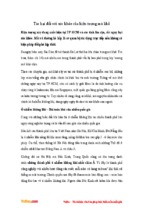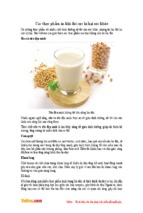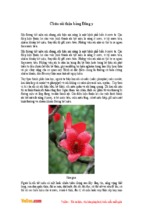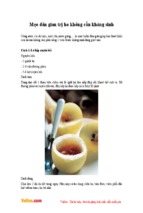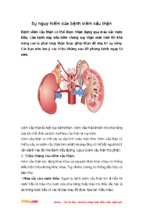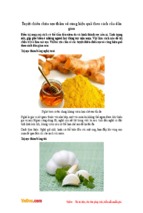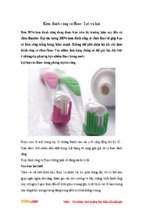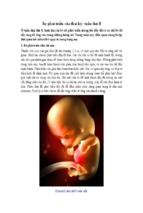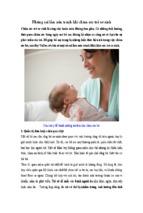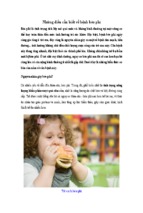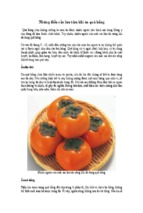Accessed from 128.83.63.20 by nEwp0rt1 on Tue Jun 05 05:23:04 EDT 2012
5678 〈1102〉 Immunological Test Methods / General Information
format that is stable. Plans should be in place to update
archived data so that, as technology changes, archived data
can still be retrieved. Regulatory agencies require that raw
data be available for various lengths of time after the completion of a study or regulatory filing. Finally, data must be
secure from corruption, alteration, or access by unauthorized personnel.■2S (USP35)
Add the following:
〈1103〉 IMMUNOLOGICAL TEST
METHODS—ENZYME-LINKED
IMMUNOSORBENT ASSAY (ELISA)
■
INTRODUCTION
Immunological Test Methods (ITM) utilize binding between an antigen (Ag) and antibody (Ab). (See Appendix 1
for a complete list of acronyms used in this chapter.) Enzyme-linked immunosorbent assay (ELISA) is one of the
most widely used ITM for characterization, release, and stability testing of biotechnology products to help ensure the
quality of biological drug substances and drug products.
The term ELISA is used here in a broader sense and includes
enzyme immunoassays (EIA), as well as alternative detection
methods, e.g., chemiluminescence and fluorescence.
This chapter provides analysts with general information
about principles, procedures, experimental configurations,
assay development, and validation for solid-phase ITM like
ELISA and can be used for the other immunoassay variations mentioned above. The chapter also covers reference
standard(s) and control(s) used for immunoassays. The information can be adapted to the specific procedures of a monograph. This chapter does not cover immunoassays for the
measurement of immune responses to product in animals or
humans (e.g, serological or cellular assays), non-immunoassays (e.g, receptor-ligand interactions), or other related
approaches.
The chapter is part of a group of general information
chapters for immunological test methods [Immunological
Test Methods—General Considerations 〈1102〉, Immunological
Test Methods—Immunoblot Analysis 〈1104〉 (proposed), and
Immunological Test Methods—Surface Plasmon Resonance
〈1105〉], and also is related to the general information chapters for bioassays [Design and Development of Biological Assays 〈1032〉, Biological Assay Validation 〈1033〉, and Analysis
of Biological Assays 〈1034〉].
Second Supplement to USP 35–NF 30
ing its binding to an immunosorbent surface and its subsequent detection by the use of enzymatic hydrolysis of a reporter substrate, either directly (as with an analyte that has
enzymatic properties or is directly labeled with an enzyme)
or indirectly (by means of an enzyme-linked antibody that
binds to the immunosorbed analyte). Qualitative results provide a simple positive or negative result for a sample. Converting quantitative to qualitative results based on a cutoff
value that separates positive and negative results is common
practice. Because the performance properties of the assay
depend heavily on the cutoff value, the process used to determine the cutoff should be evidence-based and well documented. Quantitative assays determine the quantity of the
analyte based on the interpolation of a standard calibration
curve with known analyte concentration, run simultaneously
in the same assay. This standard should be an appropriate,
preferably homologous, reference or calibration material
that is representative of the analyte(s) of interest. The power
of immunoassays has been demonstrated by the variety of
procedures that have evolved, including alternative solid surfaces such as beads of different sorts, various plastics in
plates of different configurations, and alternative detection
methods, e.g., chemiluminescence and fluorescence. ELISA
assays are widely used in the biopharmaceutical industry for
various applications such as identity, purity, potency, detection or quantitation of antibody or antigen, and other
purposes.
Basic Principles
The essential steps of an ELISA can be broken down as
follows (see Figure 1):
1. Binding of the capture reagent (generally an antibody
or antigen), which functions as an immunosorbent for
capture of the analyte, to a solid surface;
2. Removal of excess, unbound capture reagent followed
by blocking of unoccupied binding sites with a blocking
protein such as albumin, gelatin, casein, or other suitable
material;
3a. Incubation of the analyte (in the test sample or reference standard) with the capture reagent to bind the
analyte onto the solid surface, followed by the washing
away of unbound material in the test sample and detection of the analyte. Direct detection occurs when the
analyte has enzymatic activity or has been linked to a
detector molecule (e.g., enzyme); or
3b. Incubation of the analyte (in the test sample or reference standard) with the capture reagent to bind the
analyte onto the solid surface, followed by the washing
away of unbound material in the test sample and subsequent detection of the analyte (Figure 1, step 3a). Indirect detection occurs when the analyte is detected by
the addition of a secondary enzyme-labeled reagent (Figure 1, step 3b); and
4. Quantification of the analyte by addition of a substrate suitable for the detector used (e.g., TMB, 3,3′,5,5′tetramethylbenzidine), followed by comparison of the
test sample to the reference standard.
Definition
ELISA can be defined as a qualitative or quantitative solidphase immunological method to measure an analyte follow-
Official from December 1, 2012
Copyright (c) 2012 The United States Pharmacopeial Convention. All rights reserved.
Accessed from 128.83.63.20 by nEwp0rt1 on Tue Jun 05 05:23:04 EDT 2012
Second Supplement to USP 35–NF 30
General Information / 〈1103〉 Immunological Test Methods 5679
Figure 1. Essential steps for performing an ELISA.1
ASSAY DESIGN
Five general categories of ELISA are described in Table 1
and in the sections that follow. The assay designs are flexible and, depending on specific needs, can be modified from
these procedures. The choice of format depends primarily
on the amounts and purity of reagents and equipment
available. On some occasions the analyte being characterized actually is an antibody, as in the case of a monoclonal
antibody that is being developed as a drug. In this case,
anti-idiotypic or other antibodies specific for the antibody
are used to develop the assays.
Capture reagent binding, blocking, analyte binding, detector antibody binding, and analysis are the five basic steps in an ELISA. Capture reagent binding, blocking, and analyte binding steps are each followed by a washing step
to remove unbound reagents before the addition of the next reagent. Before
analysis an appropriate substrate is added, followed by measurement of the
substrate by appropriate equipment for detection. Quantitation of unknowns
takes place by comparison with a standard curve.
1
Official from December 1, 2012
Copyright (c) 2012 The United States Pharmacopeial Convention. All rights reserved.
Accessed from 128.83.63.20 by nEwp0rt1 on Tue Jun 05 05:23:04 EDT 2012
5680 〈1103〉 Immunological Test Methods / General Information
Second Supplement to USP 35–NF 30
Table 1. Representative ELISA Types
ELISA Type
Direct detection
Required Reagents
• Capture analytea
• Labeled primary antibody specific for antigen
Attributes
• Rapid because only one antibody
is used
• Uses less reagent
• Analyte is immobilized
Indirect detection
• Capture analytea
• Primary antibody specific for
antigen
• Labeled secondary detector
antibody that binds to the primary antibody
• Analytea can be used as a capture reagent or can be labeled
with a detection label
• Antibody specific for analyte
can be used for capture or labeled for detection
• Labeled secondary antibodies
to bind to primary antibody if
an indirect format is used
• Primary capture antibody specific for analyte
• Sample solution containing
analytea
• A different primary enzymeantibody conjugate specific for
analyte
• Versatile because a variety of primary antibodies can be used with
the same secondary detector
• Improved sensitivity because of
signal amplification
• Analyte is immobilized
• Good for assessing antigenic
cross-reactivity
• Appropriate for smaller proteins
with single epitopes
• Requires only a single antibody
• Analyte in solution competes for
binding to primary antibody
Competitive
Sandwich
a
• Improved sensitivity
• Good for quantitative assays for
larger multi-epitope molecules
• Analyte measured in solution
Disadvantages
• May modify the conformation of
the analyte
• Sensitive to matrix and adjuvant
components
• Not commonly used
• Poor sensitivity
• Longer because of more incubation and washing steps
• Format difficult to troubleshoot
• Limited dynamic range
• Requires relatively large amounts
of pure or semipure specific antibody
• Not suited for smaller proteins
that may have only a single epitope
or a few closely spaced epitopes
This reagent can be either purified or partially purified. The terms “analyte” and “antigen” are used interchangeably when describing ELISAs.
Direct ELISA
Directly Labeled Antibody: In this assay an antigen is
coated onto a solid surface and the remaining unbound reactive sites are blocked (Figure 2A). Then a solution containing a specific antibody labeled with a detector is added.
After incubation, the unbound antibody is washed away, followed by the addition of an appropriate substrate for the
detector used.
Directly Labeled Antigen: This assay is similar to that using a directly labeled antibody except that the antibody is
coated onto the solid surface and a labeled antigen is used
as the detector.
Indirect ELISA
In this assay an antigen is coated onto a solid surface and
then, after blocking, a solution containing a specific antibody is added (Figure 2B). After incubation, the unbound
antibody is washed away, followed by the addition of an
anti-immunoglobulin (anti-Ig) detector antibody. Anti-Ig detectors are available commercially for specific Ig classes and
subclasses from a variety of species, which makes this assay
format useful for isotyping of antibodies. In addition, the
use of a labeled anti-Ig detector amplifies the signal compared to a Direct ELISA, thereby increasing assay sensitivity.
Competitive ELISAs
Direct Antibody Competitive ELISA: This assay is used to
detect or quantitate soluble antigens (Figure 2C). It requires
an antigen-specific antibody that has been conjugated to an
appropriate detector, e.g., horseradish peroxidase, alkaline
phosphatase, ruthenium, or fluorescein. It also requires a
purified or partially purified antigen for coating. The antigen
is coated onto a solid surface, followed by a blocking step.
The antibody–conjugate is incubated with the test solution
containing soluble antigen. The mixture is then added to
the immobilized antigen, incubated, and unbound antigen-
antibody complex is washed away. Substrate is added, and
the inhibition of the reaction (e.g., colorimetric, electrochemiluminescence, fluorescence, or chemiluminescence)
is measured relative to the reaction when no competitor
antigen is added. The amount of inhibition is inversely proportional to the amount of antigen in the test sample. Competitive assays can also measure small molecules by coating
an antibody to the plate that is specific to the small molecule. The small molecule is often biotinylated with a long
linker that does not interfere with binding between the capture antibody on the plate and the small molecule. Antigen
(the small molecule) in the sample then competes with the
labeled small molecule for binding to the capture antibody.
After washing, a detection reagent (e.g., streptavidin labeled
with HRP) is added to detect the binding complex.
Direct Antigen Competitive ELISA: This assay is similar to
the Direct Antibody Competitive ELISA, except that it is used
to detect soluble antibodies. The antigen is conjugated to
the detector and the antibody is coated onto the solid
surface.
Indirect Antibody Competitive ELISA: This assay is similar
to the Direct Antibody Competitive ELISA, except that instead
of directly labeling the antibody, the test uses a labeled antiIg reagent for detection.
Indirect Antigen Competitive ELISA: This assay is similar
to the Direct Antigen Competitive ELISA, except that instead
of directly labeling the antigen, the test uses a labeled secondary antibody for detection.
Sandwich ELISA
Direct Sandwich ELISA: In this assay an antibody is immobilized onto a solid surface and blocked, and then a solution
containing a specific antigen is added (Figure 2D). After an
incubation step, the unbound material is washed away, and
a labeled detector antibody is added. This assay format requires two antibodies, each of which binds to different
epitopes on the surface of the large and complex molecule.
The two antibodies are specific for the antigen, and the an-
Official from December 1, 2012
Copyright (c) 2012 The United States Pharmacopeial Convention. All rights reserved.
Accessed from 128.83.63.20 by nEwp0rt1 on Tue Jun 05 05:23:04 EDT 2012
Second Supplement to USP 35–NF 30
General Information / 〈1103〉 Immunological Test Methods 5681
Figure 2. Schematic representations of direct, indirect, competitive, sandwich, and bridging ELISAs.2 (Ab = antibody; Ag =
antigen (or analyte); Preincub = preincubation)
tigen should be sufficiently large and complex to accommodate the binding of two antibodies.
Indirect Sandwich ELISA: Alternatively, instead of directly
labeling the detector antibody, an anti-Ig antibody detector
can be used. Indirect sandwich immunoassay formats can
be considered only if each binding reagent is from a unique
species (e.g., a sandwich assay using two mouse monoclonal antibodies for capture and detector could not be detected indirectly because the resulting signal may become
independent of the antigen concentration).
Bridging ELISA: This subset of Sandwich ELISA assays often
uses a single antibody for both capture and detection (Figure 2E). If a monoclonal antibody is used, it requires that
the target antigen have at least two identical epitopes that
are adequately spaced to prevent steric hindrance so that
one epitope binds to the capture antibody and the other
epitope binds to the detector antibody. Alternatively, a
polyclonal antibody can be used but still requires that the
target antigen be large enough to accommodate the binding of two antibody molecules. With respect to specificity
and sensitivity, bridging assays usually are suitable for most
large molecules.
CHOICE OF ASSAY
Deciding which ELISA procedure or format to use often
depends on individual choice and availability of reagents,
instruments, and other equipment. For example, sometimes
The type of ELISA format depends on the availability of reagents, the intended purpose of the assay, and the physicochemical characteristics of the
analyte of interest. For a Bridging ELISA, the capture and detector antibodies
recognize the same epitope, and therefore the target antigen must have at
least two epitopes available for binding.
2
a laboratory repeatedly engineers a particular epitope into
multiple fusion proteins. In this case, the laboratory can use
certain common qualified reagents (e.g, an antibody to a
glutathione S-transferase region in multiple fusion proteins),
facilitating rapid sandwich immunoassay development. Small
antigens with a limited number of epitopes available for antibody binding restrict ELISA format choices. If there is only
one binding epitope, then ELISA methods that use the sandwich/two-site binding or other bridging formats cannot be
used because they require at least two available epitopes for
antibody binding. In addition, small molecules are not usually used as a capture reagent on a plate because the process may interfere with binding to the detection reagent.
Examples of such small molecules are some peptides, oligosaccharides, nucleotides, and antibacterials. Analysts usually
adopt a competitive assay format for such small analytes.
Different assays and formats may demonstrate different
properties and characteristics, e.g., specificity, precision, accuracy, sensitivity, dynamic range, dose-response ratio, sample throughput, sensitivity to interference, and simplicity or
efficiency for automation. Ease of validation also may vary
between different assay protocols and formats. Assay designs with replicates in adjacent wells could be biased if
there are location effects; hence, in this case, replicates
should not be in adjacent wells. Assay designs that are convenient to perform on 96-well plates, using relatively few
single-channel pipet actions and more multi-channel pipet
actions, are usually easier to adapt to automation. Assays
with steep dose-response curves are generally better able to
deliver high precision estimates; however, some assays with
steep dose-response curves are imprecise in the EC50 and
require a wider dose range.
Official from December 1, 2012
Copyright (c) 2012 The United States Pharmacopeial Convention. All rights reserved.
Accessed from 128.83.63.20 by nEwp0rt1 on Tue Jun 05 05:23:04 EDT 2012
5682 〈1103〉 Immunological Test Methods / General Information
PROCEDURES
Solid Phase
Solid phases are available in a variety of forms (e.g, membrane, plate, or bead) and chemistries (e.g, nylon, nitrocellulose, polyvinylidine fluoride (PVDF), polyvinyl, polystyrene,
or a chemically derivatized surface). The selection of the
solid phase determines the most likely binding mechanism,
i.e., hydrophobic, hydrophilic, or covalent interactions. In
general, compared to plates, beads offer higher capacity
and are more commonly used in clinical assays whereas
plates are more commonly used to test biotechnology products. Additional information on plates is provided below.
Coating the Solid Phase—Immobilization of Capture Reagent: Capture reagents are coated onto a solid phase by
adding a solution containing the capture reagent to the surface. The most commonly used solid-phase materials for
capture reagent immobilization are plastic 96-well microtiter
plates. Those with flat-bottom wells are recommended for
spectrophotometric readings, and round-bottom well plates
are useful for visual assessment of a dye’s color development. The degree of coating is influenced by the concentration of capture reagent, temperature during coating, duration of capture reagent adsorption, the surface properties of
the solid-phase material, and the nature of the buffer of the
capture reagent solution. Although the optimum coating
concentration must be determined for each capture reagent,
concentrations of 1–10 µg/well are most commonly used.
The volume of capture reagent added to each well usually
corresponds to the sample volume that will be analyzed,
i.e., 50–100 µL. Coating duration, temperature, and buffers
are discussed separately below. During the coating procedure analysts should avoid introducing bubbles. Proteins
that bind to plastic can be denatured, which alters antigenicity. In such cases, a capture antibody or an intermediary
protein such as Protein A or Protein G can be used. In addition, streptavidin can be used if the reagent is biotinylated.
The pH of the coating buffer should be optimized based on
the isoelectric point of the capture reagent and the surface
properties of the assay plate chosen.
Microtiter Plates: The composition and commercial source
of the microtiter plate can influence binding of the capture
reagent during coating. Several microtiter plates from different suppliers should be compared using a single coating
procedure to select those that provide high specificity for
the capture reagent of interest and low nonspecific background. Comparisons of different grades of plates from a
single supplier also may be needed. Clear plates typically are
used for colorimetric ELISA, and opaque plates often are
used for chemiluminescent and fluorometric ELISA. Acidic
capture reagents may require a lower pH solution to neutralize repulsive forces between the protein and solid phase.
Peptides often require optimization of buffer pH based on
their charge for optimal coating conditions during assay development. Polysaccharides, lipopolysaccharides, or glycoproteins may be difficult to coat directly to the plate and
may require a capture antibody or a buffer that contains
lysine or glutaraldehyde. Coating with an antibody can be
enhanced by precoating the microtiter plate with Protein A
or Protein G or a combination of the two, which allows
binding to the Fc region so that the Fab portion can bind to
the analyte of interest. However, care must be taken to ensure that subsequent secondary antibodies do not react with
the Protein A- or Protein G-coated wells. In this case, for
example, chicken IgY or another appropriate antibody class
could be used. Microtiter plate formats other than the 96well variety, such as half volume 96-well or 384-well plates,
can be used to increase throughput and/or conserve
reagents.
Coating Time: Coating time depends on binding kinetics,
stability, concentration of capture reagent, and incubation
Second Supplement to USP 35–NF 30
temperature. Although different combinations of coating
times and temperatures often result in the same coating efficiency, the stability of the capture reagent (which should be
determined during method development) influences which
conditions to select. Analysts must assess the impact of varying the coating time in order to determine the robustness of
the assay procedure.
Coating Temperature: Coating temperature and time are
closely related assay parameters. The coating temperature
depends on the binding kinetics and stability of the antigen.
Higher temperatures can increase the rate of adsorption and
may shorten the coating time, but they are likely to affect
interaction sites and to reduce antigen-antibody affinity.
Typical combinations of time and temperature are 1–4 h at
ambient temperature, 15 min to 2 h at 37°, or overnight at
4°. Analysts should determine the effects of variations in
temperature in order to assess the robustness of the assay
procedure.
Buffers: Buffers used for diluents, coating, blocking, and
washing plates can affect overall assay performance. Buffer
components can interact with the test sample and inhibit
binding. They also can cause low antigen sensitivity or high
nonspecific background activity.
Diluent—Buffers [e.g., phosphate-buffered saline (PBS) or imidazole-buffered saline] with polysorbate 20 (0.01%–0.1%)
are used commonly for different ELISA steps as a diluent and
washing buffer.
Coating Buffers—Coating buffers should maximize assay consistency and promote binding of the capture reagent to the
solid phase. Commonly used coating buffers include 50 mM
carbonate, pH 9.6; 20 mM Tris-HCl, pH 8.5; and 10 mM
PBS, pH 7.2. The choice of coating buffer depends on the
nature of the individual antigens and should be determined
empirically.
Blocking Agents and Buffers—A blocking agent is a compound (e.g., protein or detergent) that should saturate the
remaining immunosorbent binding sites following capture
reagent (antibody or antigen) binding. This reduces nonspecific binding of analyte and nonanalyte components to the
immunosorbent matrix and/or the absorbed reagent. Nonspecific binding occurs when protein in the test sample
binds to the plastic of the microtiter plate or absorbed reagent instead of specifically binding to the capture reagent of
interest. Nonspecific binding can be reduced by adding
blocking reagent to the wells and by the addition of another protein such as bovine serum albumin (BSA) to the
dilution buffer. The choice of blocking agent should be governed by the nature of the capture reagent, plate, coating
buffer, test sample diluent, and related factors. If any of
these parameters changes, a change in blocking agent may
be needed. Commonly used blocking agents include BSA,
nonfat milk, gelatin, casein, normal horse serum, fetal bovine serum, polysorbate 20, and others. Several grades of
BSA are available commercially, and the optimal grade
should be empirically determined for each assay. In addition, many commercial blocking and assay diluent reagents
are available for ITMs.
Adding Samples and Reagents
Samples and reagents generally are pipetted into the
ELISA plate wells. Care should be taken to avoid cross-contamination, frothing, or bubbles. Labor-saving equipment
such as electronic pipets, automated liquid handlers, plate
washers, and robotic pipets also can be used to improve
precision, reduce analyst-to-analyst variability, and increase
throughput.
Pipets: Single, multichannel, and robotic pipets with set or
fixed volumes are available. The type and accuracy of pipets
should be evaluated for each application. Regular maintenance and professional calibration of pipets should be performed and documented.
Official from December 1, 2012
Copyright (c) 2012 The United States Pharmacopeial Convention. All rights reserved.
Accessed from 128.83.63.20 by nEwp0rt1 on Tue Jun 05 05:23:04 EDT 2012
Second Supplement to USP 35–NF 30
General Information / 〈1103〉 Immunological Test Methods 5683
Pipet Tips: A variety of pipet tips are available, some of
which are specific to the type of pipet. The type and accuracy of the pipet tip, particularly related to the viscosity and
nonspecific binding of the materials, should be evaluated for
each application.
Washing
Wash steps are included throughout the ELISA procedure
to remove the unbound coating antigen, sample, and detection reagents. Washing is critical for assay performance,
can be a source of assay failure, and is important to evaluate
during method development. Multiple approaches can be
used for washing. Manual procedures include using a
squeeze bottle, dipping the microtiter plate in wash buffer,
and adding wash buffer with a multichannel pipet or handheld multi-channel (8- or 12-pin) manifolds. Analysts should
wash carefully to avoid cross-well contamination. Automatic
microplate washers generally provide more washing consistency. Strip-well and multiwell washers are available. Most
automatic washers can be programmed for different dispensing volumes and speeds, number of washes, speed of
buffer aspiration, and amount of residual buffer left in the
well. Incorrectly programmed or maintained as well as incompletely cleaned automatic washers can cause assay variation and elevated assay background.
Incubation
ELISAs are incubated following the addition of samples
and reagents. The optimal time, conditions, and temperature of each incubation step should be determined during
method development. Incubation times vary from minutes
to overnight. Commonly used incubation temperatures are
ambient temperature, 4°, and 37°. ELISA plates commonly
are sealed or placed in a secondary container to avoid evaporation or contamination during incubation. Atmospheric
conditions such as dry or humidified incubation should be
evaluated during method development. Rocking, shaking, or
rotating the microtiter plates may be necessary or desirable
depending on the kinetics of binding.
Blocking Conditions and Nonspecific Reactions
After immobilization and removal of the unbound antigen
or antibody, unoccupied binding sites are blocked to ensure
that the measured analyte in the test article or subsequent
(detection) reagents does not bind nonspecifically to the
solid surface or to the coated antigen or antibody. If nonspecific binding occurs, any reported signal could bias the
measurement and may reduce the sensitivity and dynamic
range of the assay. Blocking is critical to ensure the sensitivity and/or specificity of the assay. Sources of nonspecific
binding fall into two general categories:
1. Ionic or hydrophobic interactions occur when binding is
mediated by nonspecific ionic or hydrophobic interactions between assay reagents and the solid surface or
another assay reagent.
2. Immunological interactions occur when binding is mediated by unintended antigen-antibody interactions.
This occurs when antibody preparations used in the
assay interact with other assay reagents. For example,
if an ELISA was designed to test a serum-derived
analyte using murine capture and detection antibodies, antibodies in the test article with reactivity to murine Ig (also known as heterophilic antibodies) could
be nonspecifically detected in the assay.
The choice of blocking agent (examples are found in the
Blocking Agents and Buffers section above) is determined empirically, and the balance between the reduction in nonspecific binding and the impact on assay sensitivity should be
assessed during method development. Cross-reactivity with
other assay reagents should be considered; for example, endogenous biotin is found in milk and serum, and serum may
contain antibody to viral or bacterial proteins. Therefore,
screening of serum lots may be necessary. The volume of
blocking solution added to the well should be greater than
the maximum reaction volume used for later steps so that
all of the potential surface area that may interfere with the
binding reaction is blocked.
In addition, Ig in the test materials can be removed by
using buffers that inhibit antibody conformation or aggregate the heterophilic antibodies, by blocking with nonimmune serum, or by removing Fc regions in critical antibody
reagents, thereby reducing or eliminating undesired immunological interactions that cannot be addressed by the
blocking reagents described above. Negative control wells
can be included to monitor nonspecific reactions. The nature of the negative control wells depends on the assay but
can include blocked wells without coating antigen, eliminating the primary or secondary antibody, or using buffer in
place of sample. Control wells also can be useful as part of
system suitability testing.
Pretreatment of Samples
Although ELISA methods are designed to measure an
analyte in complex mixtures, the presence of other materials
can prove problematic if they interfere with analyte detection. In order to ensure assay specificity, the specific procedure to treat samples to remove nonspecific interfering substances (e.g., reducing agents or precipitates) can be
determined empirically during method development and
then can be incorporated into the validated assay. Any sample-processing step should be evaluated against the potential that the treatment will alter the test article’s properties
and/or introduce further variability that results in biased
measurements. Samples, standards, and controls should be
prepared and handled in processes as similar to each other
as possible. Analysts should verify that sample pretreatments
have not damaged the sample so much that it can no
longer be measured (e.g., by spiking experiments).
Detector Antibodies
Depending on ELISA format, detector antibodies labeled
with enzyme or other labels can be used as primary or secondary reagents to enable detection of the immobilized
analyte. In a direct or competitive ELISA (Figure 2A and Figure 2C), after the analyte is bound to the immunosorbent
surface, excess analyte is washed away and the immobilized
analyte is detected using a detector antibody that is considered to be the primary antibody. In other ELISA formats
(Figure 2B, 2D, and 2E), the analyte-specific Ig (nonconjugated primary antibody) is allowed to bind to the immobilized analyte, and any excess antibody is washed away
before the addition of a detector antibody, which is termed
the secondary antibody.
To facilitate detection, in all ELISA formats that use enzyme-conjugated antibodies, a substrate specific for the conjugated enzyme is introduced into the assay system. An enzymatic reaction ensues, converting a substrate into a
soluble product that can be measured using appropriate
wavelengths and a suitable reader.
ELISA sensitivity depends on the quality of the reagents
and the detection system, including the label and substrate.
If multiple differently conjugated antibodies are available,
analysts should select one appropriate for the assay. During
this evaluation, the dilution of each conjugate that yields
desirable sensitivity and specificity should be determined using appropriate controls.
The most commonly used labeling enzymes for conjugating to antibodies include alkaline phosphatase (AP), horseradish peroxidase (HRP), and galactosidase. These enzymes
are highly specific, sensitive, and stable in catalyzing chro-
Official from December 1, 2012
Copyright (c) 2012 The United States Pharmacopeial Convention. All rights reserved.
Accessed from 128.83.63.20 by nEwp0rt1 on Tue Jun 05 05:23:04 EDT 2012
5684 〈1103〉 Immunological Test Methods / General Information
mogenic, luminescent, or fluorescent reactions. para-Nitrophenyl phosphate (pNPP) is a commonly used substrate
for AP. Commonly used substrates for HRP include TMB,
OPD (o-phenylenediamine dihydrochloride), and ABTS [2,2′azino-bis(3-ethyl-benzothiazoline-6-sulfonic acid) diammonium salt] (see Table 2). The substrates for AP and HRP
are chromogenic and result in the formation of a colorimetric product that can be measured using a spectrophotometer. Chemiluminescent and fluorescent substrates for AP and
HRP also are available, and in many cases they are available
as commercial kits. Disodium 3-(4-methoxyspiro{1,2-dioxetane-3,2′-(5′-chloro)tricyclo[3.3.1.13,7]decan}-4-yl)phenyl
phosphate (CSPD) is a known chemiluminescent substrate
for AP (see Table 2). Well-known fluorescent substrates for
galactosidase include MG (4-methylumbelliferyl galactoside)
and NG (nitrophenyl galactoside). If a chemiluminescent
substrate is used, then a luminometer is required to quantitate the formed product. A fluorometer is needed if a fluorescent substrate is used in the ELISA.
Table 2 also provides a summary of the advantages and
disadvantages of different types of ELISA substrates. Colorimetric substrates have been prevalent since the origin of
ELISAs and may yield robust assays that generally are more
cost efficient than assays that use chemiluminescent and
fluorescent substrates. Nevertheless, chemiluminescent and
fluorescent ELISA methods may yield more rapid and sensitive assays with a wider dynamic range than assays that use
a colorimetric readout. The final choice of readout should
be governed by the assay’s purpose and the requirements of
the assay.
ASSAY DEVELOPMENT AND VALIDATION
PLAN
Critical Reagent Development
Key considerations for critical reagents are source, purity,
specificity, and stability. For quality measurements, ITMs
use reference standards along with critical reagents for
Second Supplement to USP 35–NF 30
analyte capture and detection. Any changes of critical biological reagents should be evaluated (see, for example,
guidance contained in Design and Development of Biological
Assays 〈1032〉.)
Source: The availability and quality of the starting material
should be controlled so that manufacturing of the (purified)
reagent can be reproducibly and consistently performed,
potentially over several decades. Because critical reagents
are biological molecules, sources can range from chemical
synthesis (e.g., peptides) to complex biological matrices
(e.g., antibodies prepared from serum, monoclonal antibody
from ascites/cell culture, or fermentation/cell culture products). When appropriate for the intended use of the assay, a
single lot of a critical reagent can be manufactured to establish a substantial supply and to prevent lot-to-lot variability.
In other instances it may be appropriate to include in the
validation multiple lots or multiple suppliers in order to
demonstrate that the assay is sufficiently robust for its intended use.
Purity: In general, the purity of critical reagents should be
assessed to ensure the removal of impurities and manufacturing process residuals that can influence reagent performance and/or stability.
Specificity: The specificity of a critical reagent refers to its
ability to capture or detect only the analyte of interest. The
reagent must be specific to the analyte and should show
little nonspecific binding or no cross-binding to off-target
molecules in complex test materials.
Stability: The stability of critical reagents should be empirically determined to ensure assay performance over time (issues include accuracy, precision, reproducibility, and assay
drift). Long-term (months to years) stability of critical reagents under required storage conditions (e.g., with defined
temperatures and containers) should be determined so that
appropriate expiry dating can be assigned. Short-term (minutes to days) stability (and freeze/thaw and room temperature stability for frozen critical reagents) also is required to
ensure day-to-day assay accuracy, precision, and
reproducibility.
Table 2. Enzyme Conjugates and Substrates
Readout
Colorimetric
Chemiluminescent
Fluorescent
Principle of the
Enzymatic Reaction
Produces a colored
product that yields
absorbance values directly proportional to
analyte concentration
Produces a light emission that is directly
proportional to
analyte concentration
Produces excitation-induced light emission
that is directly proportional to analyte concentration
Enzyme
AP, HRP
AP
Galactosidase
Substrate
pNPP TMB
OPD
ABTS
CSPD
MG
NG
Reader
Spectrophotometer
Luminometer
Fluorometer
Advantages
• Robust
• Economical
• Reagent availability
• Wide assay
dynamic range
• Lower coating
concentrations
• More sensitive
• Rapid signal generation
• Rapid
• Sensitive
Disadvantages
• Less
sensitive
• Requires special
plates
• Costly
• Requires special
plates
• Costly
• Interference by
excipients
Official from December 1, 2012
Copyright (c) 2012 The United States Pharmacopeial Convention. All rights reserved.
Accessed from 128.83.63.20 by nEwp0rt1 on Tue Jun 05 05:23:04 EDT 2012
Second Supplement to USP 35–NF 30
General Information / 〈1103〉 Immunological Test Methods 5685
Feasibility/Pilot Studies
The steps of the process by which an ELISA method is
developed, validated, and used in routine sample analysis
are described below:
• Generate or purchase critical reagents to measure the
analyte. Determine storage conditions and stability.
• Understand the performance goals for the assay system.
• Develop the assay to the point that there is a detectable concentration response curve.
• Perform method development/robustness testing.
• Prepare the reference/calibration standard and control
and assess stability.
• Establish assay procedures, appropriate controls and
limits, assay and sample acceptance criteria, and
instrumentation.
• Determine method performance, and qualify method
for accuracy, specificity, precision, and robustness, including qualification of all applicable sample types to be
analyzed.
• Validate the assay.
• Implement the method (technology transfer) in the
testing laboratory, including training and qualification
of analysts.
• Monitor assay performance.
During assay development, the critical parameters and reagents that are required for the assay should be assessed
and set at levels that yield desired assay performance. In
many instances several parameters may be evaluated, and
well-designed experiments can accelerate assay development, particularly for assessing the potential interaction of
several inputs.
Many ELISA procedures are product specific, and external
reference/calibration standards may not be available. The
preparation and stability of reference/calibration standards
should be considered early in assay development.
Assay Validation
Assay validation is executed according to guidances from
appropriate regulatory bodies (e.g., ICH Q2) to demonstrate
that the particular test used for an analyte is appropriate for
its intended use. More information about assay validation
can be found in the general information chapter Validation
of Compendial Procedures 〈1225〉 or in general information
chapter Biological Assay Validation 〈1033〉 if the ELISA is used
as a surrogate potency assay. See Appendix 2 for additional
information.
DATA ANALYSIS
The analysis of ELISA data can be simple (e.g., a linear
calibration with inverse regression) or complex (e.g., a nonlinear calibration curve with inverse regression). The type
and rigor of data analysis depend largely on the assay system and the intended uses of the assay. For example, data
reduction may estimate a concentration (e.g., ng/mL) of an
unknown sample using a calibration curve. Other approaches include estimation of the half-maximal inhibitory
concentration (IC50) or effective concentration (EC50), estimation of the amount of a sample that yields the same
response as the EC50 (or IC50) on a standard curve, and an
estimate of the relative activity of a test sample compared to
a reference/calibration standard. More extensive guidance
about statistical methods for potency analysis are given in
general information chapters Design and Development of Biological Assays 〈1032〉 and Analysis of Biological Assays 〈1034〉.
In general, ELISA assay curves are characterized by a nonlinear relationship between the concentration of the analyte
of interest and the calculated mean response. Typically, this
response curve is defined by a sigmoidal relationship of response to concentration. A wide range of mathematical
models can fit standard/calibration curves, and analysts
should take care in the selection of an appropriate curvefitting algorithm. In other cases, ELISA assays are used for
qualitative purposes to determine whether a sample is positive or negative based on a sensitivity threshold.
Basic Statistical Analysis
Basic statistical methods are not detailed here. General information chapter Analytical Data—Interpretation and Treatment 〈1010〉 addresses important fundamentals, including
data handling; computation of means, standard deviations,
and standard errors; detection of and methods to address
nonconstant or nonnormal variation; detection of and management of outliers; and procedures for and interpretation
of statistical tests and confidence intervals. The concepts behind validation, goals, designs, analysis, and practical methods for validation are described in general information chapters Analytical Data—Interpretation and Treatment 〈1010〉,
Validation of Compendial Procedures 〈1225〉, and Biological Assay Validation 〈1033〉. General test chapter Design and Analysis of Biological Assays 〈111〉 contains guidance on combining results from independent assays.
Nonlinear Statistical Analysis
Nonlinear calibration for immunoassays draws on many
sources for statistical design and analysis. These include
methods for assessing and addressing nonconstant variance,
designs and analysis methods for experiments with complex
structures, and validation. The concepts behind linear calibration design, analysis, and inverse regression apply in
nonlinear calibration, and professional statisticians can help
apply these appropriately.
Reporting Results
Reported estimates of concentration should be understood as having an associated confidence interval based on
the results of the validation. The reported value or estimate
used to describe a sample can be based on a combined
result from multiple assays.
APPENDIX 1
Abbreviations
Ab—Antibody
Ag—Antigen
ABTS—2,2′-Azino-bis[3-ethyl-benzothiazoline-6-sulfonic
acid]diammonium salt
Anti-Ig—anti-immunoglobulin
AP—Alkaline phosphatase
BSA—Bovine serum albumin
CSPD—Disodium 3-(4-methoxyspiro{1,2-dioxetane-3,2′(5′-chloro)tricyclo[3.3.1.13,7]decan}-4-yl)phenyl
phosphate
EIA—Enzyme immunoassay
ELISA—Enzyme-linked immunosorbent assay
HRP—Horseradish peroxidase
Ig—Immunoglobulin
ITM—Immunological test methods
MG—4-Methylumbelliferyl galactoside
NG—Nitrophenyl galactoside
OPD—o-Phenylenediamine dihydrochloride
PBS—Phosphate-buffered saline
PVDF—Polyvinylidene fluoride
pNPP—para-Nitrophenyl phosphate
TMB—3,3′,5,5′-Tetramethylbenzidine
Official from December 1, 2012
Copyright (c) 2012 The United States Pharmacopeial Convention. All rights reserved.
Accessed from 128.83.63.20 by nEwp0rt1 on Tue Jun 05 05:23:04 EDT 2012
5686 〈1103〉 Immunological Test Methods / General Information
Second Supplement to USP 35–NF 30
APPENDIX 2
Additional Sources of Information about Specific Topics in Validation and Data Analysis
Analytical Data—Interpretation and Treatment
〈1010〉
X
X
X
X
Means
Standard deviations
Standard errors
Non-normality
Nonconstant
variance
Outliers
Tests
Confidence intervals
Validation
Combining results
from multiple assays
Design and Analysis
of Biological Assays
〈111〉
Biological Assay Chapters
〈1032〉, 〈1033〉, and 〈1034〉
X
X
X
X
X
X
X
X
X
■2S (USP35)
Delete the following:
■
Validation of Compendial Procedures
〈1225〉
〈1150〉 PHARMACEUTICAL
STABILITY
The term “stability,” with respect to a drug dosage form,
refers to the chemical and physical integrity of the dosage
unit and, when appropriate, the ability of the dosage unit to
maintain protection against microbiological contamination.
The shelf life of the dosage form is the time lapse from
initial preparation to the specified expiration date. The monograph specifications of identity, strength, quality, and purity apply throughout the shelf life of the product.
The stability parameters of a drug dosage form can be
influenced by environmental conditions of storage (temperature, light, air, and humidity), as well as the package components. Pharmacopeial articles should include required
storage conditions on their labeling. These are the conditions under which the expiration date shall apply. The storage requirements specified in the labeling for the article
must be observed throughout the distribution of the article
(i.e., beyond the time it leaves the manufacturer up to and
including its handling by the dispenser or seller of the article
to the consumer). Although labeling for the consumer
should indicate proper storage conditions, it is recognized
that control beyond the dispenser or seller is difficult. The
beyond-use date shall be placed on the container label.
Stability Protocols
Stability of manufactured dosage forms must be demonstrated by the manufacturer, using methods adequate for
the purpose. Monograph assays may be used for stability
testing if they are stability-indicating (i.e., if they accurately
differentiate between the intact drug molecules and their
X
X
X
degradation products). Stability considerations should include not only the specific compendial requirements, but
also changes in physical appearance of the product that
would warn users that the product’s continued integrity is
questionable.
Stability studies on active substances and packaged dosage forms are conducted by means of “real-time,” longterm tests at specific temperatures and relative humidities
representing storage conditions experienced in the distribution chain of the climatic zone(s) of the country or region of
the world concerned. Labeling of the packaged active substance or dosage form should reflect the effects of temperature, relative humidity, air, and light on its stability. Label
temperature storage warnings will both reflect the results of
the real-time storage tests and allow for expected seasonal
excursions of temperature.
Controlled Room Temperature
Controlled room temperature (see Storage Temperature
and Humidity in Preservation, Packaging, Storage, and Labeling under General Notices and Requirements) delineates the
allowable tolerance in storage circumstances at any location
in the chain of distribution (e.g., pharmacies, hospitals, and
warehouses). This terminology also allows patients or consumers to be counseled as to appropriate storage for the
product. Products may be labeled either to store at “Controlled room temperature” or to store at temperatures “up
to 25°” where labeling is supported by long-term stability
studies at the designated storage condition of 25°. Controlled room temperature limits the permissible excursions to
those consistent with the maintenance of a mean kinetic
temperature calculated to be not more than 25°. See Mean
Kinetic Temperature. The common international guideline for
long-term stability studies specifies 25 ± 2° at 60 ± 5% relative humidity. Accelerated studies are specified at 40 ± 2°
and at 75 ± 5% relative humidity. Accelerated studies also
allow the interpretation of data and information on shortterm spikes in storage conditions in addition to the excursions allowed by controlled room temperature.
The term “room temperature” is used in different ways in
different countries, and for products to be shipped outside
the continental U.S. it is usually preferable for product labeling to refer to a maximum storage temperature or temperature range in degrees Celsius.
Official from December 1, 2012
Copyright (c) 2012 The United States Pharmacopeial Convention. All rights reserved.
- Xem thêm -

